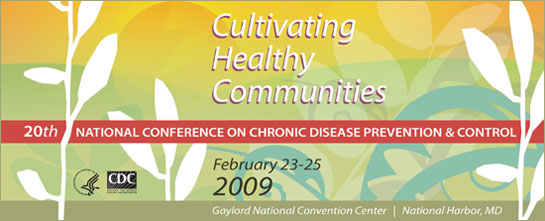 |
| 2009 Chronic Disease Conference |
 |
 |
Centers for Disease Control and Prevention
National Center for Chronic Disease Prevention and Health Promotion
(NCCDPHP)
4770 Buford Hwy, NE
MS K-40
Atlanta, GA 30341-3717 |
 |
 |
 |
|
 |
 |
 |

Conference Goal
The goal of the 20th National Conference on Chronic Disease Prevention
and Control is to advance the development of healthy communities and
eliminate health disparities by—
- Celebrating two decades of extraordinary progress against chronic
diseases and drawing on this success to accelerate progress for the next
20 years.
- Heightening awareness of the importance of chronic disease
prevention, health promotion, and health equity at the national, state,
territorial, tribal, and community levels, and building urgency for
action.
- Promoting innovations in science translation, policy, community
interventions, health communication and education, and information
science that support health-enhancing environments.
- Fostering multidisciplinary, multisectoral, and participatory
approaches to put prevention principles into practice, especially by
engaging communities experiencing the greatest health-related
disparities.
Conference Objectives
By the end of this conference, participants will—
- Identify at least two major policies and environmental changes that
have had significant impact on public health advances in cultivating
healthy communities and in reducing population-level morbidity,
mortality, and/or health-related disparities during the past 20 years.
- Describe at least two major disease prevention and health promotion
challenges facing the nation over the next 20 years and describe
potential solutions to those challenges at the national, state,
territorial, tribal, and/or local levels.
- Explain at least two new or emerging innovations in prevention
science, policies, community interventions, health communication and
education programs, or information science that can be applied in
participants’ states or local communities in the next year that will
promote healthy behaviors and/or health-enhancing community
environments.
- Commit to advancing one or more of the Conference Calls to Action.
Conference Tracks
Abstract submissions and proposals for special sessions will select a
primary track and address questions such as those below. Preference for oral
presentations will be given to abstracts that address cross-cutting issues
such as workforce development, active engagement of communities, and
integration of multiple risk and protective behaviors.
Health Policy
How can we ensure that prevention policy plays a key role in health
system reform? How are communities using policy solutions to address social
determinants of health? How can we better make the case to policy makers for
increased and sustained support of disease prevention and health promotion?
What are the implications of the electronic medical record for public health
surveillance, intervention, and ethics?
Health Equity and Disparities Elimination
How can we ensure progress in eliminating health disparities through
effective science and practices to improve the quality of life for all? What
are the data needs for developing and evaluating interventions to eliminate
health disparities?
Effective Interventions
What have we learned and how are we building on the design, integration, and
implementation of effective interventions to prevent disease and promote
health, especially those using community-based participatory strategies?
What are current and novel examples of effective individual, community,
environmental, and life-stage interventions? What areas are in greatest need
of innovative technologies for data collection and intervention delivery?
How can we best measure the success of our work? What are communities doing
to coordinate and leverage their efforts in categorical disease and
risk-factor programs to improve the overall health of communities?
Translation of Science to Practice
How can we translate scientific knowledge to real-life applications? How
can we develop both evidence-based practice and practice-based evidence? How
can we better communicate science to make a difference in people’s lives?
How can we improve health literacy through existing and new information and
communication technologies?
New Frontiers in Practices and Partnerships
How can we engage and partner with critical sectors — especially
nontraditional sectors such as agriculture, transportation, and economic
development — to expand and integrate models and practices for disease
prevention, health promotion, and health equity? What advances in health
communication, health information systems, and emerging health issues; such
as, mental health, alcohol, sleep, and arthritis hold the greatest promise
for improving the health of communities? How do we most effectively bundle
messages and tools for individuals, organizations, and communities?
Page last reviewed: May 8, 2008
Page last modified: July 22, 2008
Content source: National Center for
Chronic Disease Prevention and Health Promotion |
 |